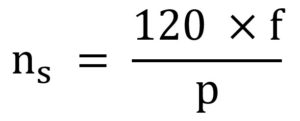Poles (Induction Motors)
Every motor has stationary magnetic poles that act like permanent magnets when energized. These poles are created by bundles of magnet wire wound together in the slots of the stator core. The number and alignment of these bundles of wires creates magnetic poles. The number of poles in an induction motor determines the motor’s speed, usually stated in revolutions per minute. If the number of motor poles is known, a motor’s rated speed can be determined using the following formula:

where ns is the synchronous speed in rpm, f is for the line frequency, and p are the number of motor poles.
Using the formula, we see that a four-pole motor operating under no-load conditions will run at 1800 rpm (120 × 60 = 7200 divided by four poles). Loaded, the motor will slip to between 1600 and 1750 rpm. A two-pole motor will operate at 3600 rpm (120 × 60 divided by two poles) unloaded and between 3000 and 3450 rpm under load.
